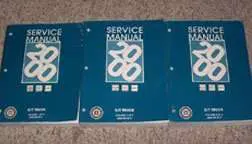2000 Chevrolet S10 Common Problems
Chevy has produced fascinating vehicles over the year, so it may be challenging to think of a vehicle that’s all about problems. It is partly true that Chevrolet is too experienced to be 100% at fault, but nothing can be perfect. There will always be one or more downsides to everything you come across; the same is valid for automobiles. This article will focus on the 2000 Chevrolet S-10.
The factor that determines the efficiency and reliability of a vehicle is a comparison of its benefits and shortcomings. For instance, Chevrolet S-10 from the early 2000s is a great vehicle that was loved by the majority. We will see how the purchase can still impact people with different interests.
Introduction to the 2000 Chevrolet S-10:
The 2000 Chevrolet S-10 has a sleek design with a fuel-efficient base engine that offers excellent handling to the driver, making him feel “in control”. This model’s performance and durability are greatly enhanced to a great extent that covers the engine, exhaust system, antilock braking system, and manual transmission. It still didn’t offer any improvement in the horsepower despite the enhancement in performance and reliability.
People should be aware of other common problems with 2000 Chevrolet S-10 before investing their money. This article will discuss a few common issues you may encounter with Chevrolet S-10 1994-2004 models.

Common Problems of Chevy S-10 Models:
The most common 2000 Chevrolet S-10 problem is the intermittent starting, but it is the tip of the iceberg. Some more Chevy-related problems are as follows:
Faulty Intake Manifold Gaskets:
If you observe a high level of engine oil with a milky tint, coolant leak behind or near the water pump, cross-contamination of coolant in the coolant reservoir and engine oil, low coolant, etc., it is much more likely that you need to check your intake manifold gaskets checked. You may have to detach the upper engine parts, like the AC compressor and fuel lines, to replace the intake manifold gaskets and get the job done.
Bad Heater Core:
It can be very irritating if the heater starts throwing cold air while the heat is on. You may even notice a sweet smell in the cabin with the windshield fogged and coolant leaking on the passenger side floor. It is all that a faulty heater core does to you!
The reason the heater throws the cold air can be the clogged heater core from sediment or old coolant. Coolant leakage spreads the sweets smell and causes issues like fogged windshields.
Flush the heater core if it is clogged and replace it if it’s damaged. You need a heater core replacement even when it is leaking.
Problems in Front Wheel Bearing:
Some Chevrolet S-10s produced a growling sound on the front wheels at higher speeds. The solution to this problem is simple; jack up the vehicle front and spin the wheel while noticing any unusual sounds coming from the wheels. The problem can be a loose or faulty bearing if the wheel gives in quickly or imparts excessive motion when you hold it at certain angles. Replace the wheel bearings; you can do it yourself using a Chevrolet S-10 Repair Manual or online guides. In addition to the service repair manual, you can also purchase the parts catalog, and the owner’s manual online.
Distributor Problems:
One of the most common issues in Chevrolet S-10 second-generation models are discussed. You anticipate a more significant problem and consider it a hazard to drive the vehicle if the engine is misfiring. The engine may turn over and fail to start in such a situation. The engine light will indicate the misfire code P0300-P0306 in such a situation, indicating the need for immediate action. Bad distributor cap and rotor, sometimes in addition to the internal parts, cause these issues.
You need to change the distributor cap and rotor routinely on the distributor near the firewall to avoid any such incident even when the issues have not appeared. You could check the Chevrolet S-10 Repair Manual to check the suggested intervals, after which you should replace the distributor parts.
Unscrew the distributor cap and look for corrosion or carbon deposits on the distributor rotor or cap. Replace them if it exhibits any such issue. It is yet again another problem that the Chevrolet service manual can help you with.
Tip: You can ease the replacement process by marking the cylinders according to the spark plug wires that connect with them.
Fuel Pump Issues:
There might be some fuel pump fault if the engine refuses to start and eventually starts with the extended crank.
A faulty valve sends the fuel back into the engine, leaving no fuel in the fuel lines. You may have to repeatedly turn the key on and off to start the engine if it has sat idle for long hours.
The whole fuel pump needs to be replaced if the problem is surfacing from it. You may prevent the fuel pump issue by preventing the complete drainage of gas from the engine.
Although the second-generation S-10 has this issue, not all Chevrolet users will experience it. Its pros dominate its cons, making it one of the top-selling Chevy models from the early 2000s.
Frequently Asked Questions
When was the S-10 Made?
Between 1982-2004
What is the 2000 S-10 Worth?
Between $926-$6053

